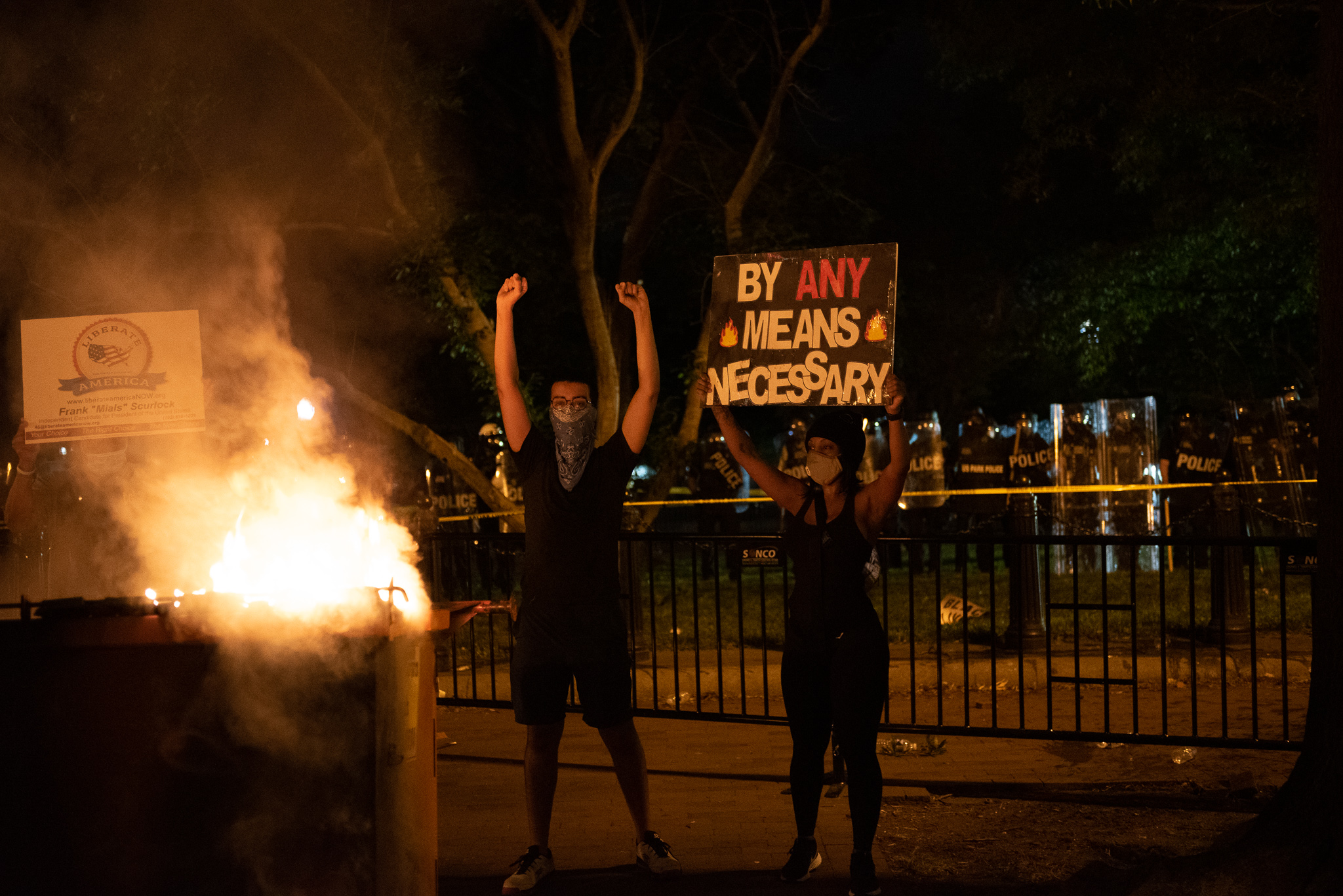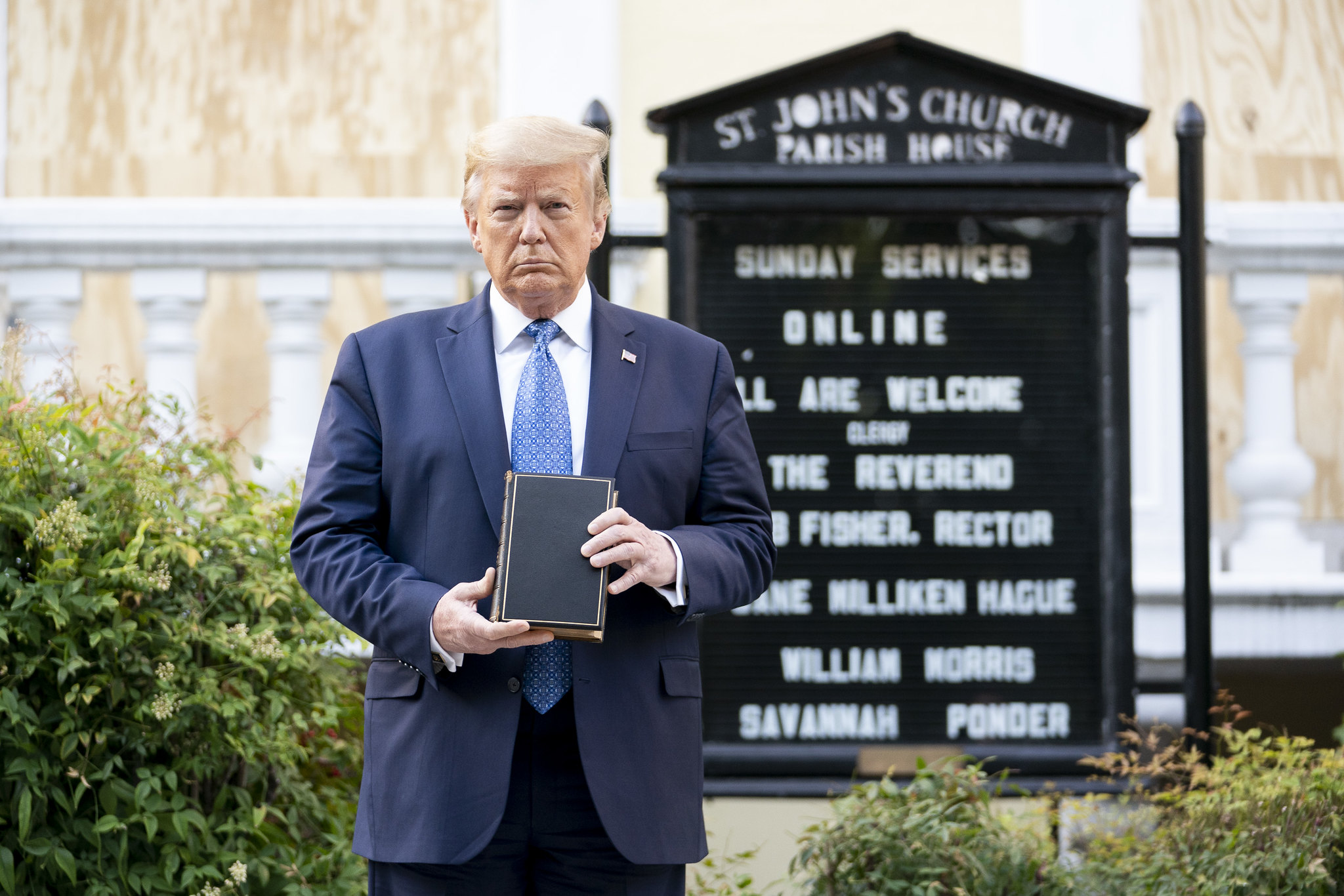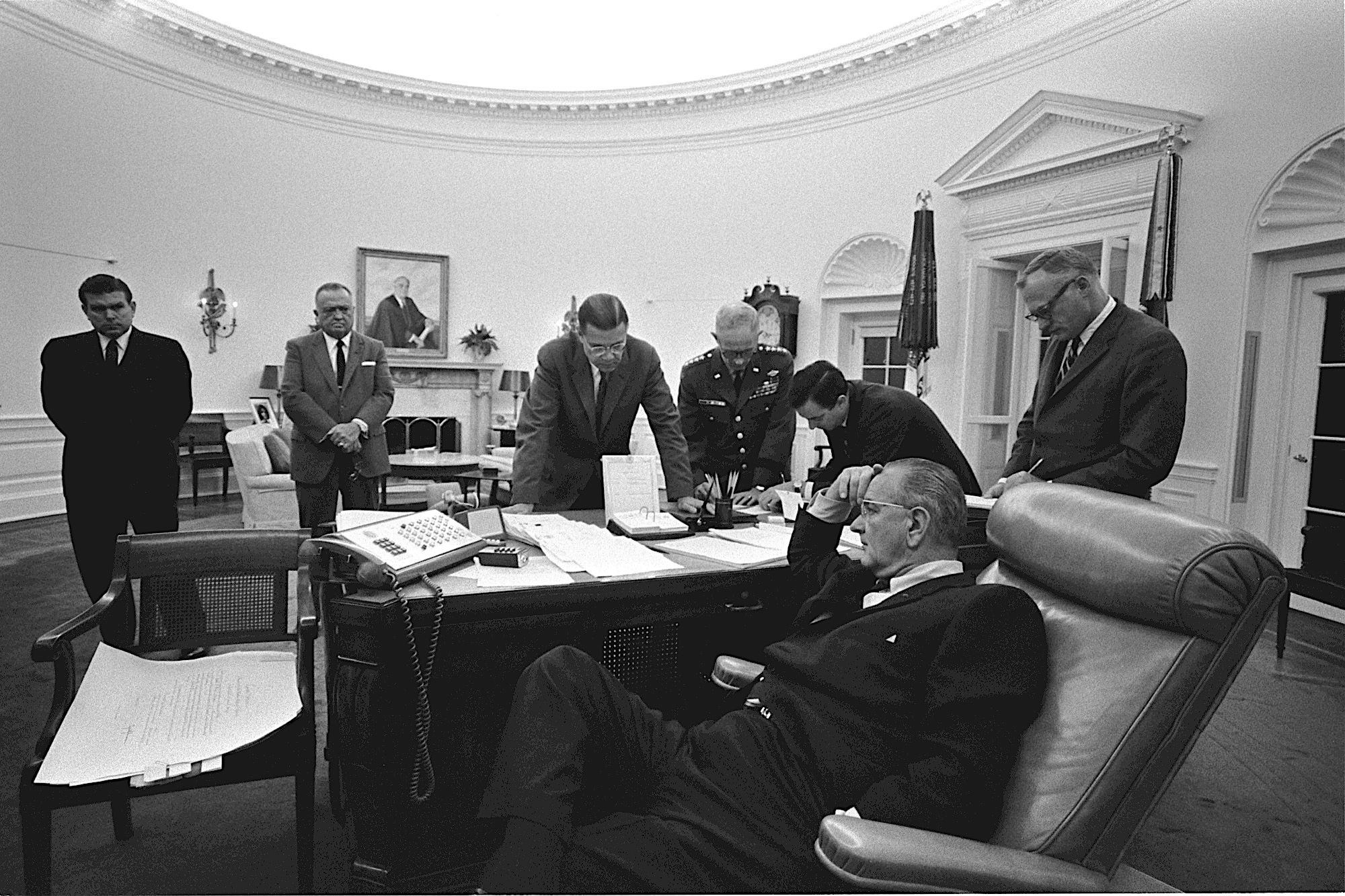
George Floyd protests in Washington, D.C., Lafayette Square on May 30, 2020. (Rosa Pineda, CC BY-SA 4.0, Wikimedia Commons)
Using federal troops to quell citizen unrest is nothing new in America, but Trump is on shaky ground.
By John Kiriakou
Special to Consortium News
 President Donald Trump this week threatened to invoke the Insurrection Act of 1807 to quell demonstrations across the country instigated by the police murder of George Floyd. The act has been invoked at least 14 times throughout history, allowing presidents to use federal troops domestically.
President Donald Trump this week threatened to invoke the Insurrection Act of 1807 to quell demonstrations across the country instigated by the police murder of George Floyd. The act has been invoked at least 14 times throughout history, allowing presidents to use federal troops domestically.
But just standing in front of a lectern in the Rose Garden and saying he’ll invoke the act won’t accomplish what Trump thinks it will. He may not even have the authority to invoke it in the first place.
The Insurrection Act, 10 U.S.C. 251-255, empowers the president to federalize the National Guard and to call out the armed forces domestically, but only in specific circumstances: When requested by a state’s legislature or governor; to address a “rebellion against the authority of the United States” or to hinder the execution of laws such that citizens are deprived of their constitutional rights.
So far, no governor or state legislature, Republican or Democratic, has asked Trump to intervene, even though he’s offered. There has been no insurrection against the federal government, even in Washington, D.C., where it was the National Guard, police and Secret Service that fired on peaceful, unarmed protestors and not vice versa. And there are no laws on the books in any state that deprive citizens of their constitutional rights.
Photo Op

President Donald J. Trump on June 1, 2020, outside St. John’s Episcopal Church, which was damaged by fire during demonstrations in nearby LaFayette Square the previous evening. (White House, Shealah Craighead)
Trump giving a speech and then walking across the street from the White House to a church for a photo op, where he waved a Bible like a guy waves a dollar bill at a stripper, does not then suddenly give him the authority to wage war against the American people.
Trump certainly tried to lay the groundwork for that war earlier in the day, when he spoke on a conference call with governors, where he called them “weak” and said they “look like jerks” for allowing demonstrations in their states.
Illinois Governor J. B. Pritzker had the guts to stand up and tell Trump that he was the one causing upheaval because of his incendiary language. In retrospect, Trump was probably hoping that one of the governors would “invite” U.S. troops into his or her state, giving Trump his cause célèbre and making him the “wartime” president he so desperately wants to be. Instead, though, he’s the president who hid in a bunker at the first sign of trouble.
Please Contribute to Consortium News’ 25th Anniversary Spring Fund Drive
Trump’s hands are tied in most of the places where he might want to send troops. New York, California, Pennsylvania and Colorado are all run by Democratic governors. Massachusetts has a liberal Republican governor.
But Trump can make all the trouble he wants in Washington, D.C., where “taxation without representation” is the mantra. Final authority in the District of Columbia rests with the federal government. Trump can call out troops in Washington and there’s nobody to stop him, unless Congress suddenly and uncharacteristically decides to take action, or unless Defense Secretary Mark Esper’s opposition causes Trump to think twice.
He might also try to construe looters or violent protestors crossing state lines as breaking federal law, allowing him to intervene in those states with federal troops even without the governors’ consent. Such a move would very likely be challenged in court.
But Trump Has Precedent

July 24, 1967: President Lyndon B. Johnson (seated, foreground) confers with (background L-R): Marvin Watson, FBI Director J. Edgar Hoover, Sec. Robert McNamara, Gen. Harold Keith Johnson, Joe Califano, Sec. of the Army Stanley Rogers Resor, on responding to riots in Detroit. (Yoichi Okamoto, Wikimedia Commons)
The question, then, is “will American troops fire on American citizens?” I think the answer is a resounding “yes.” They certainly have in the past. Just look at a handful of previous invocations of the Insurrection Act.
In 1894, President Grover Cleveland used federal troops to put down the Pullman Strike in Chicago. In 1914, Woodrow Wilson did the same in Colorado in what became known as the Colorado Coalfield War. Franklin Roosevelt did it in 1943 to put down a race riot in Detroit. And Lyndon Johnson invoked the act four times to put down riots in Detroit, Washington, Baltimore, and Chicago. In every one of those cases, U.S. troops fired on Americans. History may be repeating itself.
And if Trump doesn’t have his defense secretary’s support in sending in active-duty troops, Esper, in that same conference call with governors, did encourage them to hit protesters hard. “I think the sooner that you mass and dominate the battlespace, the quicker this dissipates and we can get back to the right normal,” he said.
Esper is calling American cities “battlespaces.” And what in the world is “the right normal?” Is that the “normal” where the police can murder black men with impunity? Is it the “normal” of the “good old days” that we had after Ferguson, Baltimore, Cleveland and Sacramento?
One other note. You may be wondering about the Posse Comitatus Act of 1878, the federal law which specifically prohibits the use of military forces in domestic law enforcement. It allowed exceptions in “cases and under circumstances expressly authorized by the Constitution or Act of Congress,” such as the Insurrection Act, which preceded it.
And then it was essentially repealed in 2012. By President Barack Obama.
John Kiriakou is a former CIA counterterrorism officer and a former senior investigator with the Senate Foreign Relations Committee. John became the sixth whistleblower indicted by the Obama administration under the Espionage Act — a law designed to punish spies. He served 23 months in prison as a result of his attempts to oppose the Bush administration’s torture program.
The views expressed are solely those of the author and may or may not reflect those of Consortium News.
Please Contribute to Consortium News’ 25th Anniversary Spring Fund Drive
Donate securely with  PayPal here.
PayPal here.
Or securely by credit card or check by clicking the red button:

Anti-BDS laws are unconstitutional
But, would Black troops fire on Black protesters?
Trump and the Bible, the all-time great American crackpot photo-op.
It’s simply unbelievable that a President would pull this stunt in the midst of a crisis.
And of course the precursor to the photo is a small army of heavily armed men tear-gassing demonstrators and surrounding Trump on his little walk with high-tech machine guns.
The photo resembles a scene from “The Blues Brothers” on “a mission for God.”
Remember, back in the ’80s, when Republicans were crapping with fear about martial law, FEMA camps, black helicopters, etc.? Now the GOP false isdemanding martial law!
Ask Chris Hedges, since he sued the Obama administration for repealing the Posse Comitatus Act and lost to the federal judiciary working for Obama’s cause. Good thing Obama is “helping” protesters understand what they should and should not do. Obama’s extra-judicial killings of American citizens only for their OPINIONS in the Middle East should give you pause in taking his advice. Ask Occupy Wall Street. Ask the pipeline protesters in North Dakota.
Quite FPI – especially regarding your latter two “Ask” statements. Interesting how people so quickly forget, gloss over the anti-rights, anti-humanity, pro-corporate-capitalist-imperialist actions of the so-called “Dems” (the Blue Faces).
There is another framework Trump might use to declare martial law: Rex 84. This was a plan developed by Reagan’s FEMA director:
hXXps://en.wikipedia.org/wiki/Rex_84
Cut to the chase, John. Donnie Murdo wants to exercise power, raw power. He makes the he makes the likes of Tricky Dick look positively saintlike. We got our business man president that the Republicans have been saying we needed and he’s a sole proprietor who’s been bankrupt three times and is headed for a fourth.
I wonder whether the reaction to suppression is only timidity, or whether it breeds direct action resistance cells.
The majority go home, a few minor shooting incidents or a bombing, a few hotheads get flushed out by the FBI.
Just sit-ins or brief stoppages, admissions of fear. When does resistance get serious, or is that no longer possible?
The civil rights act responded to rioting, but mass media and democrats no longer care at all about the unfortunate.
Do we not need US Yellow Vests, with a mix of issues, a declared leader in hiding, thorough counterintelligence?
Perhaps the Taliban taught us about DC tyranny: precision strikes on mass media, DC and its forces, then melt away.
It would be an amusing irony, after the USG walked into its own trap in AfPak, if it walks into the same trap here.
Then DC can surge and the mass media seethe, but cannot take and hold, and at last allow insurgent regions to secede.
Remember that paying for food and shelter are the first priority for even disillusioned Americans. No one wants to be a homeless begger.
I agree with your concern, John, that U$ Military troops would shoot U$ citizens.
Especially if those troops are placed in areas where the human beings they face are “different”, or perceived as “the other”.
I well remember Kent State.
The “atmosphere” then, of official hostility toward the young generally, but very specifically toward those who stood against the trumped up war against the people of Vietnam, a “war” begun, officially, on the basis of the lie that was the “Tonkin Incident”, a wholly fabricated confection, which proved that reason had flown, that guaranteed the National Guard was comprised, mainly, of those who readily believed that lie and also had been instructed to hate those deemed unpatriotic, or cowardly, it was the era of “Love it or leave it”, of “My country, right or wrong” (but always right) and the tail-end period of the ludicrous nation of “Monolithic Communism”, of the silly and mindless “Dominoe Theory”.
So, the young troops fired.
And young people, some simply on their way to the next class, died …
What if the troops, sent into unknown territory, among people who look different, and soeak differently, should panic, should see everyone they face as a threat, an enemy?
Is that not what we teach the young who join the military, that they are saving the nation from vile, and violent foes who hate the U$ for, they are told, its freedoms?
Sent to battle “thugs” and “looters”, beings already shorn of common humanity, how readily might a volunteer military, recruited from economically depressed areas where the military is, too often, seen as the only way “out” and among whose members are sociopaths or even psychopaths who enjoy the power of deciding who should live and who should die (any who have studied the “Forever” wars knows that there are always those who measure their “courage” as power, not compassion and relish a show of force and not restraint) be subject to fear and, then, feeling they are in grave danger, pull the trigger in flight or fight mode.
What would “discipline” dictate?
One imagines that there will be veterans of those wars who will speak strongly and stand forthrightly against the use of the U$ Military in the streets and neighborhoods of this nation.
One hopes that they may be harkened to, may be respected, not merely for their service, but also for their wisdom and courage to appeal to reason, not political clamorings for bloody law and ham-fisted order.
To risk mayhem for the petty ambitions of politicians and generals (in the face of a people, a society, beset by pandemic, racial and class oppressions of the most severe and crushing sort, as economic depression of a level beyond the living memory of most, likely approaches) is monumentally dangerous, stupid, and unforgivable folly.
Especially for a military empire in full eclipse, however it may bluster and bully, the writing is on the wall, not the wall at some border, but the wall at the real end of an increasingly pathetic reign of hubris and horror.
The only thing more idiotic would be to start a nuclear war.
Not to mention pretending that global environmental catastrophe is an enemy-engineered hoax – but that is something to deal with, “later”, if this absurd crux point may rationally be dealt with and thoughtfully moved beyond.
Step right up, folks, and place your bets.
Are we going to be wise?
Or stupid?
What is your guess?
We are certainly at a crossroad in our history. Here is my guess, bet.
“Of course books can, and have been, written on the subject of American violence. I hear NPR affiliated broadcasts, and other media outlets subtly trying to shift the conversation from the outrageous violence portrayed against George Floyd by Derek Chauvin, a representative of our government agencies, to other subjects such as the economic situation of some segments of our population being a cause of the protests in our streets. I wholeheartedly disagree with this shift. We should instead be having a discussion on the “violence that the United States of America” has always represented to the world. In a sense George Floyd could be the flame that will shed light on all the injustice which is our nation’s history. Whether it be racial injustice, economic injustice or health and environmental injustice our country and its saturation with violence have been with us since our very founding. The vast majority of us have been controlled by the propaganda disseminated by schools, government and media since our early childhood declaring America’s greatness. This propaganda must be uncovered and brought out into the light of day if we are ever to be able to live peaceably amongst our own people and with others around the world. We missed our opportunity to rise up with the assasination’s of Martin Luther King and JFK and their resulting government cover-ups. What this speaks for us as “the People” in so many ways is we are what we allow our government to portray us as, a violent people. We are not a violent people; but, we continue to run with a violent government. Our parents tried to instill this on us in our youth, “we are an image of the company we keep”. Many of us, as now, did not heed that advice. As a 75 year old white male, Vietnam veteran (Capt, pilot and Minuteman Missile Crew Commander) and growing up in the South, I have the background and life experience to say what I am saying. As a citizen of this country, I am no longer able to be proud to be associated with the bad company my country of violence represents and has always represented, as it is a reflection on my character. Is this nation salvageable? I don’t know the answer to my question; but, my guess is that it is not. Our very history as a nation conceived in violence, tolerating violence and continuing to look aside at our government’s violence cannot survive. This history and the indifferent conduct by us all helps me in forming my opinion. With our very Constitution giving us, the People, the “right and the responsibility” to turn out a government which no longer represents us and “we the People” sitting idly by as witnesses while its knee is on our necks shows a cowardice and a reputation of subservience which is rightly deserved. Our Constitutional right as established by our “forefathers and founders” has been for too long ignored. Now, Human Caused Climate Change further exasperated by our tolerance for our government’s military violence against the rest of the world in its endless wars most likely will not allow the time nor the economic capability for the real changes our population needs to make. As we have seen for so many years, elections do not make a dime’s worth of difference in a nation controlled by wealth and which depends on the violence of war to support the majority of its economy. We are a nation of violence. We are just another of history’s violent empires, that will certainly fail. We are like the ferocious dinosaur, Tyrannosaurus Rex, screaming and roaring while drowning in the tar pit of oil wealth as we surely will. And for some seeming inexplicable reason we will all sit idly by as those cowardly Minneapolis cops did and watch it happen.”